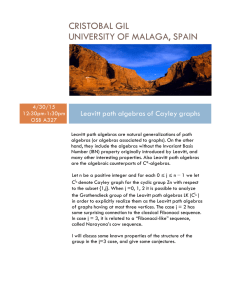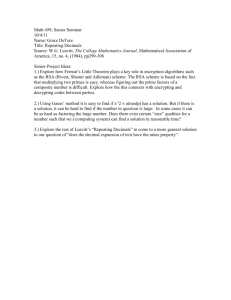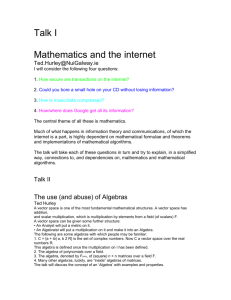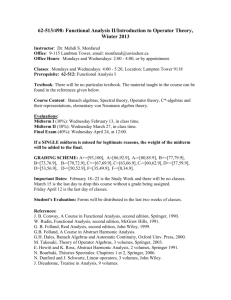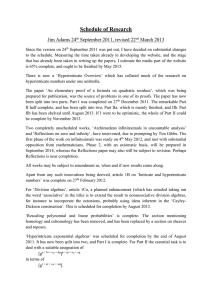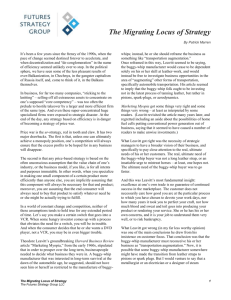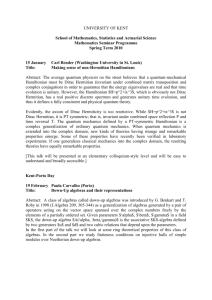Leavitt path algebras: An Introduction UW Algebra Seminar Pre-talk May 20, 2014
advertisement
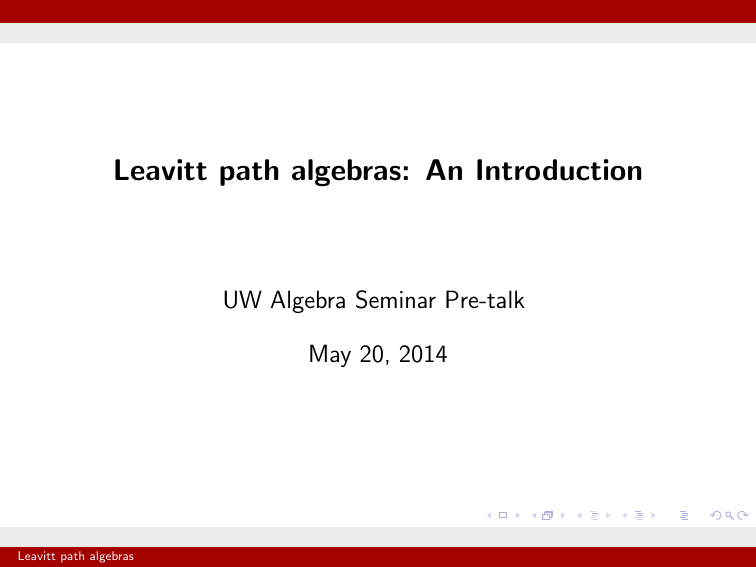
Leavitt path algebras: An Introduction
UW Algebra Seminar Pre-talk
May 20, 2014
Leavitt path algebras
General path algebras
Let E be a directed graph.
E = (E 0 , E 1 , r , s)
•s(e)
e
/ •r (e)
The path algebra KE is the K -algebra with basis {pi } consisting of
the directed paths in E . (View vertices as paths of length 0.)
In KE , p · q = pq if r (p) = s(q),
0 otherwise.
In particular, s(e) · e = e = e · r (e).
Note: E 0 is finite ⇔ KE is unital; in this case 1KE =
Leavitt path algebras
P
v ∈E 0
v.
Building Leavitt path algebras
b.
Start with E , build its double graph E
Leavitt path algebras
Building Leavitt path algebras
b.
Start with E , build its double graph E
E =
t
u
•
•
|
|>
|
|
|
|
e |
h |
||
||
~||
||
/ •w
/ •x
•v
= Q i
j
f
g
Leavitt path algebras
Example:
Building Leavitt path algebras
b.
Start with E , build its double graph E
E =
Example:
t
u
t
u
•
•
|
|>
|
|
|
|
e |
h |
||
||
~||
||
/ •w
/ •x
•v
= Q i
j
f
g
b =
E
•
>•
| L
||
h |||
e ||
|
|| ∗
||f ∗
~|u | h
t|
w
/•
/ x
= Q W i i∗ j •
f
e∗
•vW
g
g∗
Leavitt path algebras
j∗
Building Leavitt path algebras
b.
Construct the path algebra K E
Leavitt path algebras
Building Leavitt path algebras
b.
Construct the path algebra K E
Leavitt path algebras
b:
Consider these relations in K E
Building Leavitt path algebras
b.
Construct the path algebra K E
b:
Consider these relations in K E
(CK1)
e ∗ e 0 = δe,e 0 r (e) for all e, e 0 ∈ E 1 .
(CK2)
v=
Leavitt path algebras
P
{e∈E 1 |s(e)=v } ee
∗
for all v ∈ E 0
Building Leavitt path algebras
b.
Construct the path algebra K E
b:
Consider these relations in K E
(CK1)
e ∗ e 0 = δe,e 0 r (e) for all e, e 0 ∈ E 1 .
(CK2)
v=
P
{e∈E 1 |s(e)=v } ee
∗
for all v ∈ E 0
(just at those vertices v which are not sinks, and which emit only
finitely many edges)
Leavitt path algebras
Building Leavitt path algebras
b.
Construct the path algebra K E
b:
Consider these relations in K E
(CK1)
e ∗ e 0 = δe,e 0 r (e) for all e, e 0 ∈ E 1 .
(CK2)
v=
P
{e∈E 1 |s(e)=v } ee
∗
for all v ∈ E 0
(just at those vertices v which are not sinks, and which emit only
finitely many edges)
Definition
The Leavitt path algebra of E with coefficients in K
b / < (CK 1), (CK 2) >
LK (E ) = K E
Leavitt path algebras
Leavitt path algebras: Examples
Some sample computations in LC (E ) from the Example:
t
b =
E
u
•
•
| L
|>
|
|
|
|
h |
e|
|
|
|| h∗
||f ∗
|
~
|
u
t
/ •w
/ x
= Q W i i∗ j •
f
e∗
•vW
g
g∗
ee ∗ + ff ∗ + gg ∗ = v
h∗ h = w
Leavitt path algebras
hh∗ = u
j∗
g ∗g = w
g ∗f = 0
ff ∗ = ... (no simplification)
Leavitt path algebras: Examples
Some sample computations in LC (E ) from the Example:
t
b =
E
u
•
•
| L
|>
|
|
|
|
h |
e|
|
|
|| h∗
||f ∗
|
~
|
u
t
/ •w
/ x
= Q W i i∗ j •
f
e∗
•vW
g
g∗
ee ∗ + ff ∗ + gg ∗ = v
h∗ h = w
hh∗ = u
j∗
g ∗g = w
g ∗f = 0
ff ∗ = ... (no simplification)
But (ff ∗ )2 = f (f ∗ f )f ∗ = f · r (f ) · f ∗ = ff ∗ .
Leavitt path algebras
Leavitt path algebras: Examples
Standard algebras arising as Leavitt path algebras:
Leavitt path algebras
Leavitt path algebras: Examples
Standard algebras arising as Leavitt path algebras:
E = •v1
e1
Then LK (E ) ∼
= Mn (K ).
Leavitt path algebras
/ •v2
e2
/ •v3
•vn−1
en−1
/ •vn
Leavitt path algebras: Examples
Standard algebras arising as Leavitt path algebras:
E = •v1
e1
/ •v2
e2
/ •v3
•vn−1
Then LK (E ) ∼
= Mn (K ).
E = •v f
Then LK (E ) ∼
= K [x, x −1 ].
Leavitt path algebras
x
en−1
/ •vn
Leavitt path algebras: Examples
y3
E = Rn =
•vQ f s
y2
y1
yn
Then LK (E ) ∼
= LK (1, n), the classical “Leavitt algebra of order n”.
Leavitt path algebras
Leavitt path algebras: Examples
y3
E = Rn =
•vQ f s
y2
y1
yn
Then LK (E ) ∼
= LK (1, n), the classical “Leavitt algebra of order n”.
LK (1, n) is generated by y1 , ..., yn , x1 , ..., xn , with relations
xi yj = δi,j 1K and
n
X
i=1
Leavitt path algebras
yi xi = 1K .
Leavitt path algebras: Examples
y3
E = Rn =
•vQ f s
y2
y1
yn
Then LK (E ) ∼
= LK (1, n), the classical “Leavitt algebra of order n”.
LK (1, n) is generated by y1 , ..., yn , x1 , ..., xn , with relations
xi yj = δi,j 1K and
n
X
yi xi = 1K .
i=1
Note: A = LK (1, n) has A A ∼
= A An as left A-modules:
a 7→ (ay1 , ay2 , ..., ayn ) and (a1 , a2 , ..., an ) 7→
n
X
i=1
Leavitt path algebras
ai xi .
Things we know about Leavitt path algebras
The main goal in the early years of the development: Establish
results of the form
LK (E ) has algebraic property P ⇔
E has graph-theoretic property Q.
(Only recently has the structure of K played a role.)
Leavitt path algebras
Things we know about Leavitt path algebras
We know precisely the graphs E for which LK (E ) has these
properties: (No role played by the structure of K in any of these.)
1
simplicity
2
purely infinite simplicity
3
(one-sided) artinian; (one-sided) noetherian
4
(two-sided) artinian; (two-sided) noetherian
5
exchange
6
prime
7
primitive
Leavitt path algebras
(∗∗)
The monoid V(R), and the Grothendieck group K0 (R)
Isomorphism classes of finitely generated projective (left)
R-modules, with operation ⊕, denoted V(R).
(Conical) monoid, with ‘distinguished’ element [R].
Leavitt path algebras
The monoid V(R), and the Grothendieck group K0 (R)
Isomorphism classes of finitely generated projective (left)
R-modules, with operation ⊕, denoted V(R).
(Conical) monoid, with ‘distinguished’ element [R].
Theorem
(George Bergman, Trans. A.M.S. 1975) Given a field K and
finitely generated conical monoid S with a distinguished element I ,
there exists a universal K -algebra R for which V(R) ∼
= S, and for
which, under this isomorhpism, [R] 7→ I .
The construction is explicit, uses amalgamated products.
Bergman included the algebras LK (1, n) as examples of these
universal algebras.
Leavitt path algebras
The monoid V(LK (E ))
For any graph E construct the free abelian monoid ME .
X
generators {av | v ∈ E 0 };
relations av =
aw
r (e)=w
Leavitt path algebras
The monoid V(LK (E ))
For any graph E construct the free abelian monoid ME .
X
generators {av | v ∈ E 0 };
relations av =
aw
r (e)=w
Using Bergman’s construction,
Theorem
(Ara, Moreno, Pardo, Alg. Rep. Thy. 2007)
For any field K ,
V(LK (E )) ∼
= ME .
P
Under this isomorphism, [LK (E )] 7→ v ∈E 0 av .
Leavitt path algebras
The monoid V(LK (E ))
Example.
E1 d
3r
Leavitt path algebras
$2
2
The monoid V(LK (E ))
Example.
E1 d
3r
Not hard to show:
Leavitt path algebras
$2
2
ME = {z, A1 , A2 , A3 , A1 + A2 + A3 }
The monoid V(LK (E ))
Example.
E1 d
3r
Not hard to show:
$2
2
ME = {z, A1 , A2 , A3 , A1 + A2 + A3 }
Note: ME \ {z} ∼
= Z2 × Z2 .
So V(LK (E )) \ {0} ∼
= Z2 × Z2 .
Here LK (E ) 7→ A1 + A2 + A3 = (0, 0) ∈ Z2 × Z2 .
Leavitt path algebras
The monoid V(LK (E ))
Example: For each n ∈ N let Cn denote the “directed cycle”
graph with n vertices.
Then it’s easy to show that MCn = Z+ , and so MCn \ {0} = N.
So in particular V(LK (Cn )) \ {0} is not a group.
Leavitt path algebras
C∗ -algebras
Theorem
(Cuntz, Comm. Math. Physics, 1977) There exist simple
C∗ -algebras generated by partial isometries.
Denote by On .
Subsequently, a similar construction was produced of the “graph
C∗ -algebra” C ∗ (E ), for any graph E . In this context,
On ∼
= C ∗ (Rn ).
Leavitt path algebras
C∗ -algebras
Theorem
(Cuntz, Comm. Math. Physics, 1977) There exist simple
C∗ -algebras generated by partial isometries.
Denote by On .
Subsequently, a similar construction was produced of the “graph
C∗ -algebra” C ∗ (E ), for any graph E . In this context,
On ∼
= C ∗ (Rn ). For any graph E ,
LC (E ) ⊆ C ∗ (E )
as a dense ∗-subalgebra. In particular, LC (1, n) ⊆ On .
(But C ∗ (E ) is usually “much bigger” than LC (E ).)
Leavitt path algebras
C∗ -algebras
Properties of C∗ -algebras. These typically include topological
considerations.
Leavitt path algebras
C∗ -algebras
Properties of C∗ -algebras. These typically include topological
considerations.
1
simple
2
purely infinite simple
3
stable rank, prime, primitive, exchange, etc....
Leavitt path algebras
C∗ -algebras
For a vast number of (but not all) properties ..
LC (E ) has (algebraic) property P ⇐⇒
C ∗ (E ) has (topological) property P.
Leavitt path algebras
C∗ -algebras
For a vast number of (but not all) properties ..
LC (E ) has (algebraic) property P ⇐⇒
C ∗ (E ) has (topological) property P.
... if and only if LK (E ) has (algebraic) property P for every field K .
Leavitt path algebras
C∗ -algebras
For a vast number of (but not all) properties ..
LC (E ) has (algebraic) property P ⇐⇒
C ∗ (E ) has (topological) property P.
... if and only if LK (E ) has (algebraic) property P for every field K .
... if and only if E has some graph-theoretic property.
Still no good understanding as to Why.
Leavitt path algebras
C∗ -algebras
For a vast number of (but not all) properties ..
LC (E ) has (algebraic) property P ⇐⇒
C ∗ (E ) has (topological) property P.
... if and only if LK (E ) has (algebraic) property P for every field K .
... if and only if E has some graph-theoretic property.
Still no good understanding as to Why.
Note: O2 ⊗ O2 ∼
= O2 .
Leavitt path algebras
C∗ -algebras
For a vast number of (but not all) properties ..
LC (E ) has (algebraic) property P ⇐⇒
C ∗ (E ) has (topological) property P.
... if and only if LK (E ) has (algebraic) property P for every field K .
... if and only if E has some graph-theoretic property.
Still no good understanding as to Why.
Note: O2 ⊗ O2 ∼
= O2 .
But (2011, three different proofs) LK (1, 2) ⊗ LK (1, 2) ∼
6 LK (1, 2).
=
Leavitt path algebras
